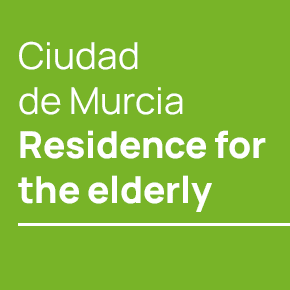- Region
- Águilas
- Alhama de Murcia
- Jumilla
- Lorca
- Los Alcázares
- Mazarrón
- San Javier
-
ALL AREAS & TOWNS
- AREAS
- SOUTH WEST
- MAR MENOR
- MURCIA CITY & CENTRAL
- NORTH & NORTH WEST
- TOWNS
- Abanilla
- Abarán
- Aguilas
- Alamillo
- Alcantarilla
- Aledo
- Alhama de Murcia
- Archena
- Balsicas
- Blanca
- Bolnuevo
- Bullas
- Cañadas del Romero
- Cabo de Palos
- Calasparra
- Camping Bolnuevo
- Campo De Ricote
- Camposol
- Canada De La Lena
- Caravaca de la Cruz
- Cartagena
- Cehegin
- Ceuti
- Cieza
- Condado de Alhama
- Corvera
- Costa Cálida
- Cuevas De Almanzora
- Cuevas de Reyllo
- El Carmoli
- El Mojon
- El Molino (Puerto Lumbreras)
- El Pareton / Cantareros
- El Raso
- El Valle Golf Resort
- Fortuna
- Fuente Alamo
- Hacienda del Alamo Golf Resort
- Hacienda Riquelme Golf Resort
- Isla Plana
- Islas Menores & Mar de Cristal
- Jumilla
- La Azohia
- La Charca
- La Manga Club
- La Manga del Mar Menor
- La Pinilla
- La Puebla
- La Torre
- La Torre Golf Resort
- La Unión
- Las Palas
- Las Ramblas
- Las Ramblas Golf
- Las Torres de Cotillas
- Leiva
- Librilla
- Lo Pagan
- Lo Santiago
- Lorca
- Lorquí
- Los Alcázares
- Los Balcones
- Los Belones
- Los Canovas
- Los Nietos
- Los Perez (Tallante)
- Los Urrutias
- Los Ventorrillos
- Mar De Cristal
- Mar Menor
- Mar Menor Golf Resort
- Mazarrón
- Mazarrón Country Club
- Molina de Segura
- Moratalla
- Mula
- Murcia City
- Murcia Property
- Pareton
- Peraleja Golf Resort
- Perin
- Pilar de la Horadada
- Pinar de Campoverde
- Pinoso
- Playa Honda
- Playa Honda / Playa Paraíso
- Pliego
- Portmán
- Pozo Estrecho
- Puerto de Mazarrón
- Puerto Lumbreras
- Puntas De Calnegre
- Region of Murcia
- Ricote
- Roda Golf Resort
- Roldan
- Roldan and Lo Ferro
- San Javier
- San Pedro del Pinatar
- Santiago de la Ribera
- Sierra Espuña
- Sucina
- Tallante
- Terrazas de la Torre Golf Resort
- Torre Pacheco
- Totana
- What's On Weekly Bulletin
- Yecla


- EDITIONS:
 Spanish News Today
Spanish News Today
 Alicante Today
Alicante Today
 Andalucia Today
Andalucia Today
History of Murcia, Part 4
History of Murcia part 4, Mediaeval Murcia
The History of Murcia Capital is written in 6 parts. To access the other sections, click below:
Part 1, Prehistoric Murcia, Click Prehistoric Murcia
Part 2, Of Romans and Visigoths, Click Romans and Visigoths
Part 3,Moors and Mursiya, Click Mursiya is born
Part 4,Mediaeval Murcia, Click Mediaeval Murcia
Part 5,From 16th to 18th Century, Click Murcia 16th to 18th Century
Part 6, From the end of the 18th Century to the beginning of the 21st, 18th to 21st Centuries
Mediaeval Murcia, Decline of the Moors and the Reconquist
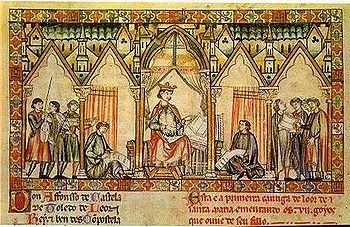 As the 13th century dawned, Moorish power was in decline.
As the 13th century dawned, Moorish power was in decline.
The battle of Las Navas de Tolosa in 1212 broke the domination of the Almohad Dynasty in Spain, and in 1224 forces dwindled as Andalusian based troops were shipped back to Morocco to fight a succession war, leaving Al-andalus, Moorish occupied Spanish territories, weak. By 1228 Al-andalus was fragemented and the powers of Castile y León and Aragón pushed South.
Throughout the next 20 years the old strongholds of Al-andalus fell one by one, and at the beginning of 1243, Murcia was included in the slow process of conquest, the Treaty of Alcaraz handing control of Murcia to the Christians.
As part of the armistice deal, Murcia became a vassal state under Muslim governors,the King of Castile, Fernando III, would take half of the income of the emirate. In return, the Moors were guaranteed that that their property and religion would be respected.
On 1st May, 1243, Prince Alfonso entered the city of Murcia and took control peacefully, Cartagena falling 2 years later in 1245, and on the 28th March, 1244, the Treaty of Almizra was signed, agreeing the frontier between Aragón and Castile, solving some of the political tensions which had arisen between the two conquering powers.
The Mudéjar Uprising of 1264-1266
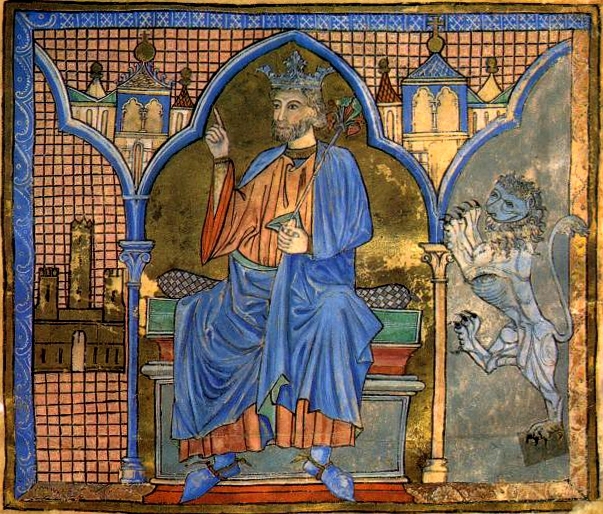 However, Fernando III died in 1252, and Prince Alfonso took the throne of Castile, becoming Alfonso X, nicknamed "El Sabio" the wise one.
However, Fernando III died in 1252, and Prince Alfonso took the throne of Castile, becoming Alfonso X, nicknamed "El Sabio" the wise one.
Alfonso’s aim was to encourage more Christians to inhabit the area and to give the Kingdom of Castile greater influence over the Kingdom of Murcia, but his attitude caused protests from the Moorish community, amidst accusations that he was not respecting the terms of the treaty of Almizra.
Eventually the complaints lead to protest, then revolt, and during the Mudéjar uprising of 1264 the capital city of Murcia and many other towns were taken over by the militant Moors.
It took 2 years of fighting to crush the revolt, and Alfonso X was only able to subdue the rebels with the help of his father-in-law, Jaime I “El Conquistador” of Aragón, who reconquered the city of Murcia two years later, in 1266. However, although this brought peace, it also changed the landscape of the Region, as vast tracts of land were given to those who had supported the King in his fight to regain Murcia for the Castilian crown and mass expulsions left the countryside de-populated.
 The rebels were outlawed, many leaving Murcia to relocate in the last Islamic bastion in Spain: Granada, although some families who had played no part in the revolts remained on their farms.
The rebels were outlawed, many leaving Murcia to relocate in the last Islamic bastion in Spain: Granada, although some families who had played no part in the revolts remained on their farms.
Following this first "Reconquista" the reconquest of Murcia, the noble knights who had accompanied Jaime, mainly from Catalunya and Aragón, all of them hungry to increase their personal wealth and power by gaining new concessions, took control of vast tracts of both Murcia and what are now the neighbouring municipalities. They left their names as a legacy, names which are familiar to residents in the Region today : Pachecho, Roldán, Roda...
With the nobility came the Knights of Santiago, and new Christian immigrants from the north, who brought their cults: Santa Eulalia who was honoured in her sanctuary at Totana, San Blas, the Trinitarian monks originally settling in Murcia before relocating to what is now San Javier, a chapel to San Blas still in the original location, many traces across the region.
Although the nobility attempted to lure settlers onto their new lands to provide income, there were insufficient numbers to replace the quantity of Moors who had occupied the land for the last 500 years, and there was a significant drop in the population.
The distribution of land (and power) also gave rise to conflicts of interest between the monarchy, the church and the nobility.
Many of the outlying areas of Murcia are already mentioned in documents from the 13th century, when land was redistributed after the Reconquista of Murcia. These places were judicially and even ecclesiastically dependent on the city of Murcia, and most of them did not have their own church.
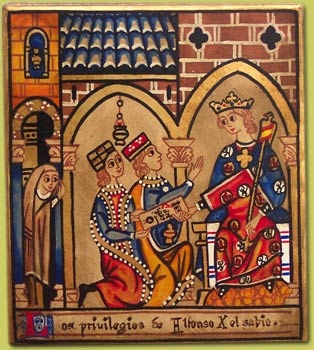 There were now three main sectors of the population in the City of Murcia; the Christians, who occupied the most central parishes; the Muslims, who were grouped around the Arrixaca; and the Jews, who inhabited the area next to the Puertas de Orihuela.
There were now three main sectors of the population in the City of Murcia; the Christians, who occupied the most central parishes; the Muslims, who were grouped around the Arrixaca; and the Jews, who inhabited the area next to the Puertas de Orihuela.
Alfonso X “The Wise” made frequent visits to the city, and made it the capital of the new Christian “Kingdom of Murcia”, as well as one of three cities in which he held court, together with Seville and Toledo. He himself preferred the safety and strategic advantages of the castle at Monteagudo, which had been built by the Moorish "Wolf King" Ibn Mardanis, and which is today better known as the location upon which the Cristo de Monteagudo stands, an enormous figure of Christ atop a rocky outcrop , visible from the Motorway between Orihuela and Murcia.
The cityscape of Murcia also underwent important changes during his reign, as mosques disappeared to be replaced by the first big churches of the city. Where the Aljama mosque had stood, in the 14th century construction work began on the Cathedral of Santa María, the remains of the mosque still visible in the Cathedral Museum inside the cathedral.
Just across the road from the Cathedral is the Conjunto Monumental of San Juan de Díos, the remains of the original Moorish wall still visible in its basement as the first church was erected on the same location. Around these focal buildings streets grew, populated by the workshops which gave them their names: Platería (silversmiths), Trapería (clothes shops), Jabonerías (soap-makers), etc.
At the same time commercial activity grew in importance as cattle fairs and market garden products began to define the economy of the area.
Chaos at the end of the 13th century, the war of succession
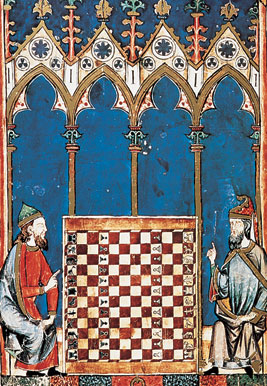 The last years of the century were chaotic.
The last years of the century were chaotic.
A combination of natural factors, the lack of farming population to feed the city, and the civil war which resulted following the death of Alfonso X’s eldest son Fernando, all made the latter part of the 13th century a difficult time for Mediaeval Murcia.
The weather, as across much of Mediaeval Europe at this time included a series of droughts and floods, which in their turn exacerbated illness and plague.
The succession crisis was caused when the heir to the throne of Alfonso X, Fernando de la Cerda, died in 1275, fighting the Moroccan and Granadan armies at Écija sparking a civil war.
His natural heirs were his two young sons, Fernando and Alfonso de la Cerda the preferred choice of Alfonso X, but his younger brother Sancho claimed he was the natural heir to the throne, and by this point in his reign, Alfonso X had lost the support of his nobles, who chose instead to support the claim of Sancho.
Alfonsoss wife, Violant of Aragon, took the two young princes to Aragón, where they remained in the fortress of Játiva for 13 years.
A bitter civil war broke out, and in 1282 Alfonso was forced to accept Sancho as his heir, few places remaining loyal to him, amongst them Murcia. He died, bitter and angry in 1284, leaving a will in favour of his grandsons, leaving Castile to Sancho and León to the young prince Alfonso de la Cerda, a will disregarded by Sancho who was crowned Sancho IV.
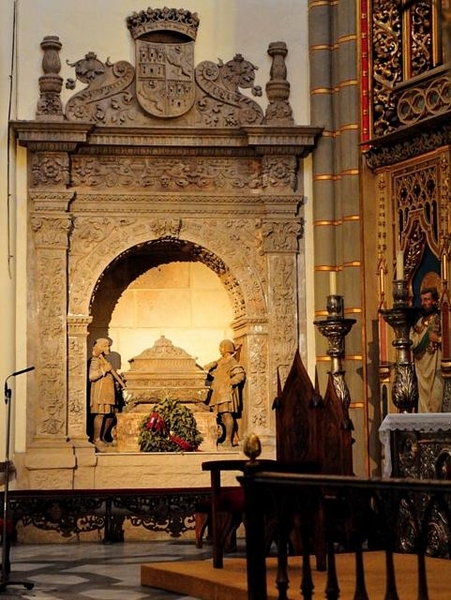 He also left his heart to Murcia, as a thanks for it´s loyalty, the heart housed within Murcia Cathedral today.
He also left his heart to Murcia, as a thanks for it´s loyalty, the heart housed within Murcia Cathedral today.
Following the death of Alfonso, the bitter fight for the succession continued, with nobles supporting the young grandsons of Alfonso continuing the wars against Sancho IV.
In 1288 King Alfonso III of Aragon released Prince Alfonso de la Cerda from the fortress, supporting his claim for the throne, and in 1289 Prince Alfonso de la Cerda was declared the King of Castile in name, part of the deal being the concession of Murcia to the Kingdom of Aragon, although it wasn´t his to give away, with Sancho IV on the throne.
The Kingdom of Aragon wanted Murcia, because it was the gateway to Granada, and as long as it was in the hands of their old arch-rival, Castile y León, Aragon was blocked from Granada.
However, in 1291, Alfonso III of Aragon died and was succeeded by his son, James II of Aragon.
Sancho IV of Castile in turn, died in 1295, his throne inherited by his son, Ferdinand IV of Castile who was only ten years old.
This opened the doors for the conquest of Murcia, as James II of Aragon formed an alliance with the enemies of the young King of Castile and in 1296 invaded, capturing Murcia for the crown of Aragon.
However, in 1304 Jaime II “El Justo” of Aragón and Fernando IV of Castile, who by now was 18, signed the Treaty of Yerrellas, by which Murcia was returned yet again to Castile and the River Segura became the frontier between the Crown of Aragón and the Kingdom of Castile.
The weakness of the Monarchy and the power of Don Juan Manuel
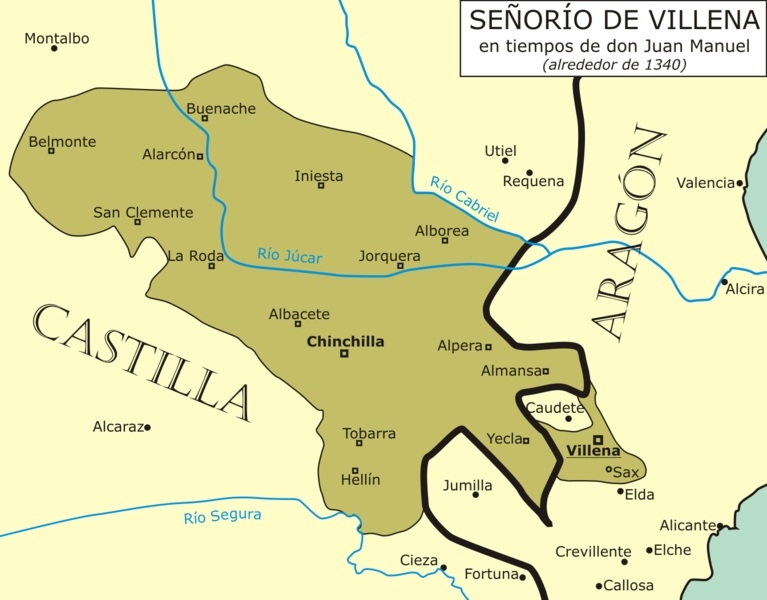 The division of the kingdom between Aragón and Castile brought about a reorganisation of political power and a transfer of property to various important groups and families, the most important of which were the Order of Santiago (a military religious order which owned vast tracts of land and property throughout Spain - Click Order of Santiago), the Bishopric of Cartagena and the Manuel family, the head of which was the powerful and ambitious Don Juan Manuel, the Superior Governor of the Kingdom of Murcia, a title he had inherited from his father in 1284.( Click Don Juan Manuel)
The division of the kingdom between Aragón and Castile brought about a reorganisation of political power and a transfer of property to various important groups and families, the most important of which were the Order of Santiago (a military religious order which owned vast tracts of land and property throughout Spain - Click Order of Santiago), the Bishopric of Cartagena and the Manuel family, the head of which was the powerful and ambitious Don Juan Manuel, the Superior Governor of the Kingdom of Murcia, a title he had inherited from his father in 1284.( Click Don Juan Manuel)
The Monarchy at the end of the 13th century was weakened considerably by its youth, the son of Sancho IV, Ferdinand IV reigning between 1295 and 1312, inheriting the throne aged 10, and his successor, Alfonso XI, King at the age of just one, who ruled from 1312 to 1350.
With the Monarchy weakened by the rivalries among the infant Kings regents, the Kingdom of Murcia effectively became the territory of Don Juan Manuel.
Don Juan Manuel was the nephew of Alfonso X, his father being one of Alfonsos brothers, and himself was Lord of Villena and Duke of Peñafiel, an immensely wealthy and influential nobleman. ( see map)
Under the protection of Don Juan Manuel, other families began to occupy important posts on the political hierarchy of the kingdom, including the Fajardos, who received property and titles from him.
This inevitably led to social tension, with many being against the monopoly of rich families in governing the city and holding important posts.
But it was a fundamentally insecure territory, lying as it did on the border between Castile and Aragón, on the Mediterranean from where the Berbers launched frequent raids, and uncomfortably close to the Moorish kingdom of Granada.
The disputes between the Houses of Manuel and Fajardo.
 The death of Don Juan Manuel in 1348 meant a long period of tension and conflict in the heart of the governing classes, as a protracted power struggle developed in the kingdom.
The death of Don Juan Manuel in 1348 meant a long period of tension and conflict in the heart of the governing classes, as a protracted power struggle developed in the kingdom.
The estate of Villena and the governorship of Murcia were inherited by his son, Fernando Manuel.
But at this time the Fajardo family (the future Marquises of Los Vélez) had already become one of the most important in the capital city, and were supported by the Order of Santiago as well as being strengthened by their blood ties with the Ayala family.
The family had powerful supporters in the Order of Santiago and the Castilian Royal family, their military support of the battle against the moors earning them valuable credibility, which in this era meant the acquisition of land, wealth and influence.
In the second half of the 14th century, the conflicts between the Manuels and the Fajardos became more frequent as they fought for political control of the municipality.
This struggle eventually went the way of the Fajardos, to the detriment of the Manuels, and the Fajardos became the dominant power in Murcia.
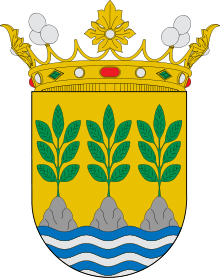 Pedro Fajardo became the Governor of Murcia, a position held by three successive generations of Fajardos, a powerful position which enabled him to consolidate his familys power, until the fusion of Spain into one nation by the "Catholc Monarchs" Queen Isabella I of Castile and King Ferdinand II of Aragón and their marriage in 1469.
Pedro Fajardo became the Governor of Murcia, a position held by three successive generations of Fajardos, a powerful position which enabled him to consolidate his familys power, until the fusion of Spain into one nation by the "Catholc Monarchs" Queen Isabella I of Castile and King Ferdinand II of Aragón and their marriage in 1469.
They created one nation, centralising the power of the throne in all the kingdoms of the peninsula, and the Fajardos, loyal supporters of the Monarchy, basked in their favour.
As well as the social tension caused by the increased wealth of these few families, Murcia suffered on other fronts.
There was a period of economic crisis and epidemics tore through the city: in the plague of 1395-96, 6,000 inhabitants lost their lives. After the epidemic came agricultural crisis and famine, which reduced still further the population of Murcia and the Huerta, closing the 14th century with a depopulated city weakened by disaster.
Map showing the lands of Don Juan Manuel. Credits: Señorío de Villena en época de don Juan Manuel, alrededor de 1340}} |Source=Elaboración propia a partir de diferentes gráficos y descripciones, sobre el Mapa Oficial de Carreteras del Estado







